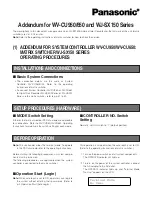
8
Rev 2.3 • 14 Oct 08
2. Introduction
Switching Configurations
Mono Channels
AES signals are composed of several parts, including a preamble, left channel, right channel, user
bits, and channel status bits. When received as an AES signal, the signal is retained as an AES sig-
nal for internal routing to the output card. The crosspoint array on the output card breaks apart the
signal, separating out the left and right channels to create two mono channels. The mono channels
are then switched as separate signals, recombining left and right channels into new stereo signals.
The channel status bit and user bits are passed through. When the signal is distributed as an AES
output, the preamble, channel status bit and user bits are added back to the left and right channels to
create a stereo signal.
Individual left or right channels can be combined with other individual channels and distributed as
a new channel-pair combination (stereo signal). For example, a live news report may capture the
news reporter’s voice on the left channel and the background noises on the right channel. By split-
ting the AES signal into its left channel and right channel, the news reporter’s voice (left channel)
can be paired with a different background noise (right channel). If only one channel is present, the
other channel is silent.
To perform mono switching, an external AES reference signal must be connected to maintain syn-
chronization (see
on page 57). How mono signals are recombined
and routed to outputs is determined by the router control system. For more information on mono
signal switching, see
Setting Jumpers and Switches on Cards and Card Sets
Switching Configurations
Switching is performed by the output card. Each output card receives signals from the input card
via the motherboard and routing commands from the control card. The inputs are then sent to a
crosspoint array on the output card that performs the switching.
Figure 2-2 shows the basic architecture of the NV5128 switching configuration and the relationship
between the backplanes and the input cards and output cards. Backplanes house connections that
receive and distribute signals to and from the router. For more information, see
Each “X” (crosspoint symbol) represents a 16 input x 16 output crosspoint array. Taken together,
eight crosspoints create a 128 input x 16 output crosspoint array. This unique architecture creates a
fully non-blocking matrix such that an input can be switched to any output, and one input to one
output, or one input to many outputs.
Summary of Contents for NV5128
Page 1: ...User s Guide NV5128 Multi Format Router...
Page 44: ...34 Rev 2 3 14 Oct 08 2 Introduction Active Cards...
Page 92: ...82 Rev 2 3 14 Oct 08 6 Maintenance Obtaining Service...
Page 102: ...92 Rev 2 3 14 Oct 08 8 Glossary Glossary...
Page 106: ...96 Rev 2 3 14 Oct 08 A Part Numbers Power Supplies...
Page 114: ...104 Rev 2 3 14 Oct 08 Index...
















































